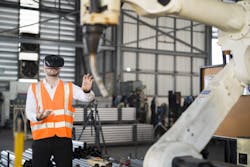Spatial Computing and Digital Twin Drive Interactive AR Simulations
Wearable technologies and 5G wireless connectivity have long had an affinity for one another. Wearables can allow end-users to become walking, talking sensors capable of generating valuable data insights that can be used to improve workplace safety and ergonomics. In addition, augmented reality (AR), when paired with a wearable device, can grant field service professionals working in dangerous conditions access to hands-free schematics, instruction manuals, and even real-time audio-video feeds for remote assistance from distant subject matter experts. However, because harsh industrial conditions can often render the use of physical cabling difficult or impossible, the reliable wireless access provided by 5G has been indispensable to these technologies’ deployment in many fields.
In a similar vein, the deployment of digital twin simulations has also had a synergistic relationship with 5G, as its improved connectivity has enabled large quantities of data to be transmitted in real-time with minimal latency issues. Now, in the spirit of convergence that characterizes so much of Industry 4.0, 5G wireless connectivity, AR, and digital twin simulations are becoming more closely connected as new spatial computing platforms emerge to grant workers and engineers immersive access to digital replicas of various environments.
For instance, PTC’s recently released Vuforia Engine Area Targets software—which is an extension of the company’s Vuforia AR enterprise platform—bills itself as the first piece of software on the market capable of creating fully immersive digital replicas of spaces up to 300,000 square feet in size. These digital twins set themselves apart from other CAD representations by allowing human workers to interact with them using AR interfaces to operate machinery virtually and better understand how the environment is being utilized for either training or workflow optimization purposes.
Area Targets builds its simulations by leveraging support from 3D scanner technology provided by software company Matteport and producer of geological survey instrumentation Leica 3D. In addition, an indoor mobile mapping system developed by spatial intelligence company NavVis is used to assist in generating reportedly photorealistic digital twins of spaces including factories, malls, offices, and other complex indoor environments.
Potential applications for Area Targets’ spatial computing capabilities include: optimizing various procedures within a given environment by acquiring a more complete picture of worker movements within the space over a period of time; providing data to machine learning algorithms to fuel spatial analytics that can improve performance; and gaining insight into how a physical space is used to make more informed design and layout decisions that enhance utilization, efficiency, and safety.
About the Author
David Miller
Former Senior Technical Writer

Leaders relevant to this article:
